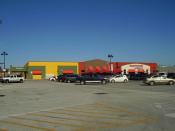Current Market Conditions of Wal-MartWal-Mart, like many organizations, has a set of market trends which must be faced on an ongoing basis. Team A has looked into a few of these market trends, and addresses how each of these trends will or will not change. Research is compiled on trends such as market structure, the impact of new companies entering the market, prices, technology, productivity, cost structure, price elasticity of demand, competitors, supply and demand analysis, and the impact of government regulations. By discussing these market trends one can see how Wal-Mart has managed to continue to thrive and grow in today's economy.
Market StructureIn today's business world many would consider Wal-Mart as a monopoly. The reality is that while many other retails stores would disagree, Wal-Mart's market structure is an oligopoly. The philosophy followed by Wal-Mart since the beginning was to offer customers the lowest price in the market.
Wal-Mart's market structure follows the cartel model, "a cartel is a combination of firms that acts as if it was a single firm, a cartel is a shared monopoly" (Colander, 2004, p.33). Even though Wal-Mart is the largest corporation in the world, other firms, such as Target and K-Mart, form part of Wal-Mart's biggest competition. These retail stores affect how Wal-Mart determines prices in order to provide customers "everyday low prices." This strategic pricing decision is not only a characteristic of the oligopoly structure; it also allows Wal-Mart to be the leading firm in the market.
Impact of New Companies Entering the Market"Wal-Mart is bracing for the entry of Tesco PLC, the largest U.K. retailer, to the U.S. this year. Tesco plans to open a chain of convenience stores, called Fresh & Easy Neighborhood Markets, featuring prepared foods" (Bloomberg News, 2007). Tesco's grocery markets are small and neighborhood friendly,


